
by Laura Tiu | Nov 26, 2018
Red Tide has been a persistent presence in the Panhandle since September and responsible for many reported fish kills and respiratory distress in some people. Over the past week, red tide was still present in low to medium concentrations in or offshore of Escambia County to Bay County.

Jack-knife fish killed by red tide Miramar Beach, Florida
Red tide is a natural occurrence and Florida experienced red tides long before humans settled here. The tides originate 10-40 miles off shore and winds and currents bring them inshore. Red tide is fueled by nutrient typically stemming from land-based runoff.
During winter, the northerly winds and southbound currents will push the tide back offshore. There was hope that Hurricane Michael might help carry the red tide back out to sea. Unfortunately, it seems the nutrient run-off from the storm’s heavy rain or retreating storm surge may have contributed to the intensity and duration of the bloom.
In our economy, which is heavily dependent on tourism, the red tide is continuing to take a toll, especially on waterfront businesses. According to the Florida Fish and Wildlife Conservation Commission, store-bought and restaurant served shellfish are safe to eat during a red tide bloom because shellfish are monitored for safety and tested for red tide toxins before they are sold. The edible parts of crabs, shrimp and fish are not affected by the red tide organism and can be eaten, but guts should be discarded.
Many remember the local red tide bloom in 2015. The longest red tide bloom ever recorded lasted 30 months from 1994 to 1997. Warmer water due to climate change is predicted to cause algae to bloom more often, more intensely, and in more water bodies. It is imperative that we reduce nutrient inputs to our lakes, rivers, estuaries and coastal ocean waters today.
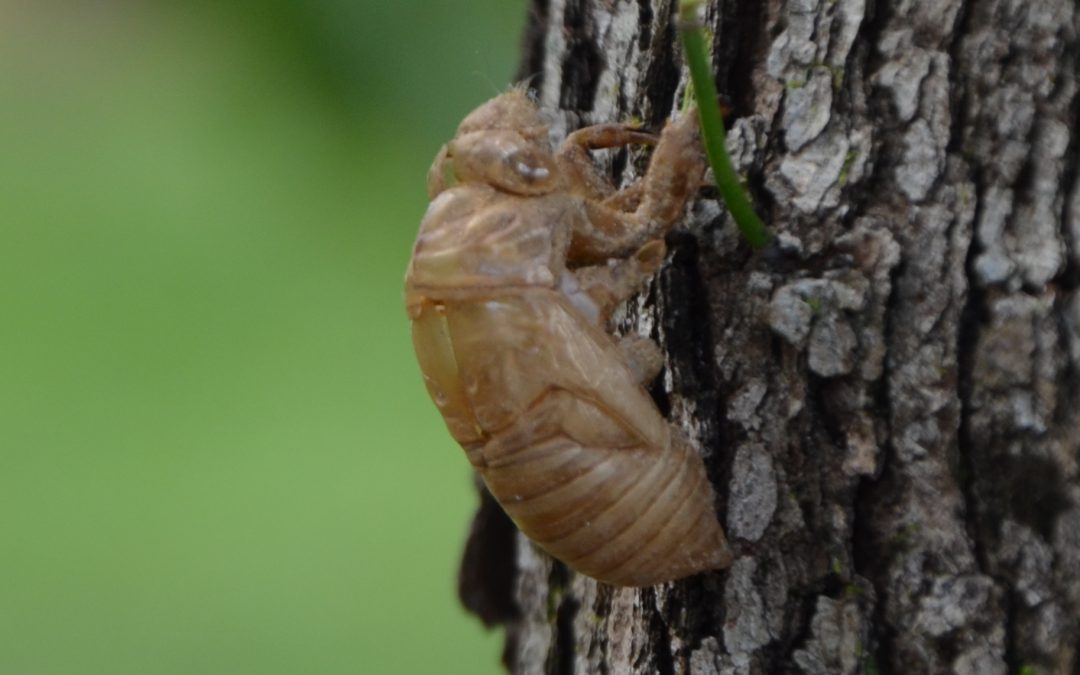
by Les Harrison | Oct 26, 2018
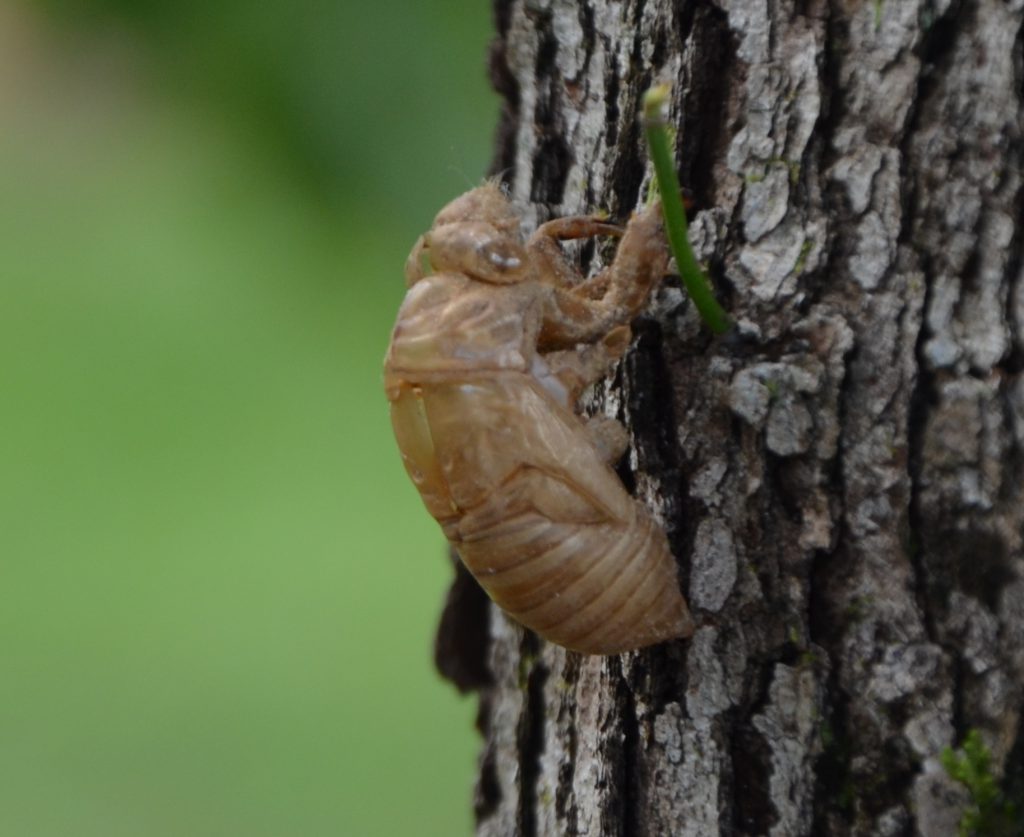
Only a shell of its former self, the exoskeleton shed by a cicada is all that remains of the previous night’s long pursuits.
Autumn evenings in the panhandle are usually beginning to reflect the official change of seasons with cooler air and a slight lessening of the raucous din created by insects and birds. The recent early-fall hurricanes have brought the area a wide breath of hot, humid air, delaying the long anticipated start of relief from the sultry summer environment.
Anyone hearty enough to take an early evening walk in north Florida will experience a continuation of the frenetic activity and riotous sounds typical to summer in the south. The near deafening call of cicadas (Magicicada spp.) is part of the cacophony.
Once commonly identified as locust in the region, their near-mechanical buzzing originates from the protection of foliage in trees and bushes during the day or twilight hours. During the dark hours they sing often and relocate frequently.
It is important to note cicadas are not the locust of infamy which shred the green, lush landscapes and foretells famine. While locust and cicadas are both insects, the similarities end there.
These seldom seen or captured insects known for their boisterous, sometimes undulating, chorus do leave strategically placed souvenirs for the sharp-eyed observer. This discarded residue of their early life stages is a highly valued tool for many elementary school boys with a prank in mind. The hard shell is harmless, but under the right conditions does have a certain shock value appreciated by juvenile miscreants.
Their nymph stage skeletons are often seen on the trunks of trees, shrubs stalks and even the siding of buildings. The opaque brown shells are abandoned when the cicada outgrows it and then emerges to form a new exterior.
The process is similar in other insect species with an exoskeleton having very limited potential for growth and expansion. The rigid coating provides this creature an armored surface to fend off the challenges of being small and small in a big hungry world.
In some states, cicadas are famous for their periodic appearance in colossal numbers, sometimes as many as 1.5 million per acre. These once every 13 to 17 year swarms do not occur in Florida which has an insect friendly environment.
The 19 Florida cicada species fall into three groups based on overall size measured by the length of the forewings. They produce their songs with timbals, paired drum-like structures on the sides of the abdominal segments.
A muscle attached to the timbal plate causes the timbal ribs to pop inward and project outward when relaxed. Flexed rapidly, the cicada chorus can deliver hours of uninterrupted night music.
In Florida, only males have timbals and the females are mute. Most sounds made by males are calling songs which serve to attract the silent females.
Cicada nymphs live in underground burrows where they feed on xylem sap from roots of grasses or woody plants. Because xylem sap is low in nutrients, complete nymph development takes several years to successfully mature.
All cicada species molt four times underground. When the cicada nymph is ready for its fifth and final molt it makes its way to the soil’s surface. It climbs a short distance up a tree trunk or stem, anchors itself and molts for the last time becoming an adult.
If male, the new cicada will add its contribution to the nightly festivities. If female, she will quietly wait for that special, one in a million, nocturnal crooner.
To learn more about north Florida’s noisy night insects, contact the local UF/IFAS County Extension Office. Click here for contact information.
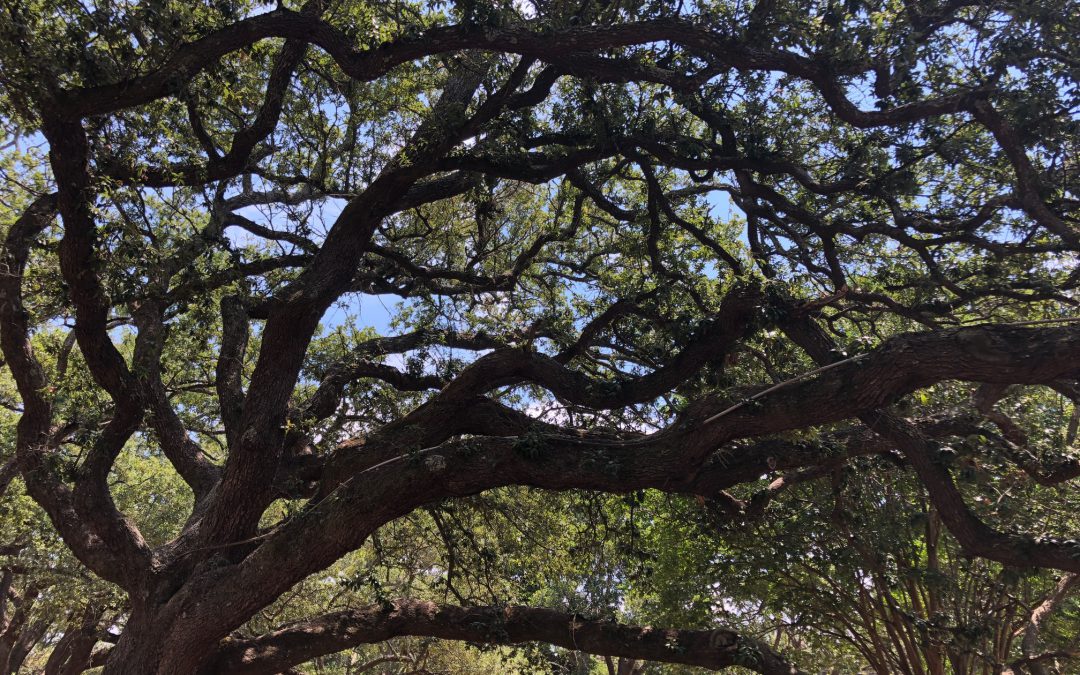
by Carrie Stevenson | Oct 26, 2018
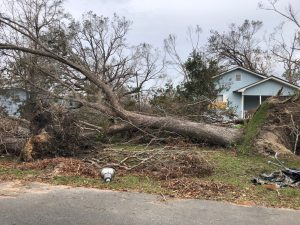
Large trees can cause serious damage in a storm, but it is important to salvage as many as surviving trees as possible. Photo credit: Carrie Stevenson
It has been more than two weeks since devastating Hurricane Michael landed hard on the coast of Florida. Central-Panhandle counties from the Gulf to the Alabama line are in full recovery mode, struggling to return to normal after many days without power and clean water. A strong category 4 hurricane, Michael brought sustained winds of 155 mph, with gusts likely much higher—many instruments that measured wind speed failed and blew away with the onslaught of the storm.
Unfortunately, with winds this strong, trees of every shape and description blew down, bringing with them serious damage to homes, vehicles, and power lines. In the immediate aftermath of a storm, it is important to perform “tree triage” using the same method as emergency room personnel as they decide which patients to treat first, based on urgency.
Hazard trees causing or leading to unsafe conditions should be given priority. These would be limbs and trunks on top of houses, power lines, blocking roads, or leaning in precarious situations that could blow down on people or property. Once roads are cleared and dangerous trees and limbs are removed, homeowners can move their attention to downed trees that are lying out of harm’s way or leaning away from property.
It is important to remember that many injuries from hurricanes happen after a storm—often when physically and emotionally exhausted storm victims are using heavy machinery at elevated heights. Always be willing to ask for help, whether from volunteers, neighbors, or landscape professionals. Use proper safety precautions when utilizing chainsaws, ladders, tractors, and other machinery.
On a more positive note, many trees can be salvaged after a storm. In particular, younger, newly planted trees can often be righted or pruned and still grow to maturity. Don’t fall into the trap of clearing every tree from your property—healthy or not—out of fear. Trees are extraordinarily valuable, and particularly with all of the tree loss it is more important than ever to save as many trees as you can. These trees will provide much-needed shade, oxygen, air and stormwater filtration, and wildlife habitat. Learn the names of your trees that survived or had less damage, and plant more of those after recovery. Many long-lived species like magnolia, live oak, and cypress can weather storms better than other species.
It is important to continue monitoring any surviving trees for damage. Many trees, particularly pines, can be susceptible to disease, insect damage, and fungus after a storm and it may be several months before the damage is fully evident. After Hurricane Ivan, many pine forests and individual trees that survived the storm were lost to pine bark beetles within the following year.
For detailed information on tree assessment and making wise decisions, the IFAS Trees and Hurricanes publication has great photos and examples. Be sure to check it out and contact your local county Extension office if you have questions.
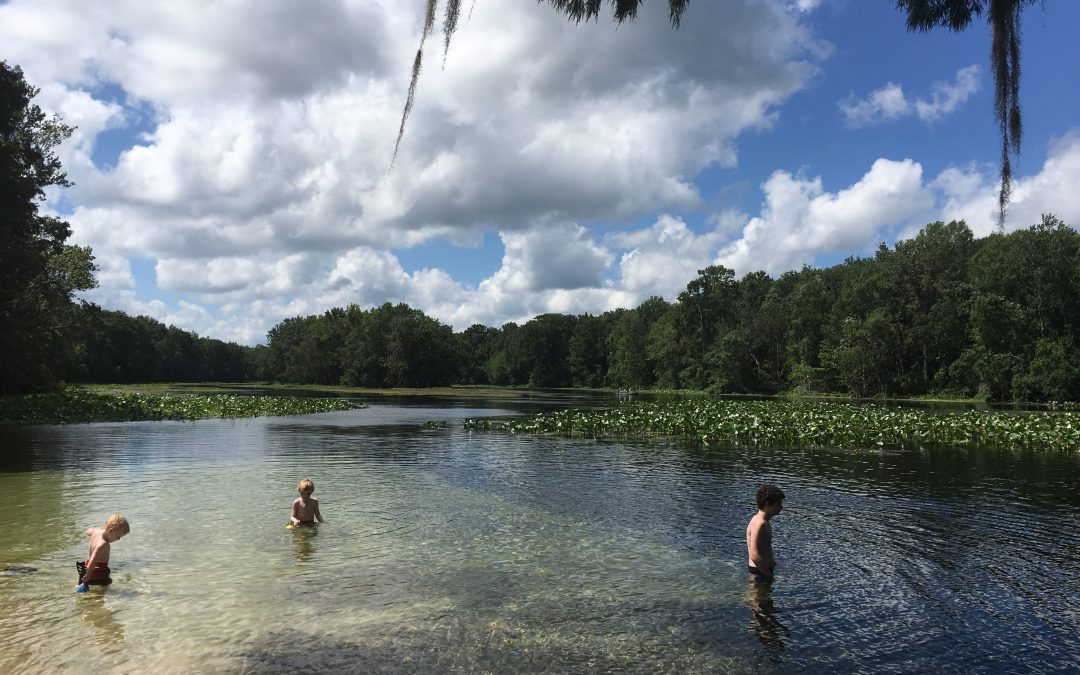
by Les Harrison | Sep 28, 2018
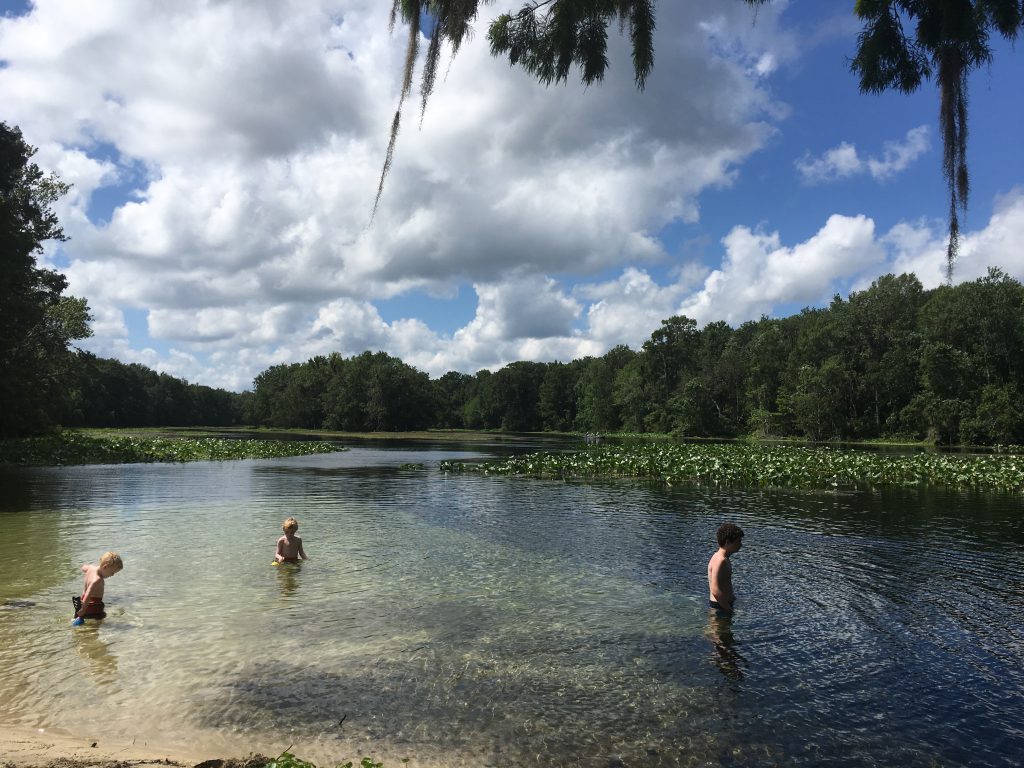
The Wacissa River offers paddlers the opportunity to see north Florida unfiltered.
Being off the beaten path has many advantages. In the case of a spring-fed river, it translates to less pressure from human use and a great opportunity for those who do visit to experience the “real Florida”.
The Wacissa River, located in the southern half of Jefferson County, Florida, is near the crossroads identified as the town of Wacissa. There is a blinking light, a post office, and two small convenience stores where beer, ice and snacks can be purchased.
Access to the river is about two miles south of the blinking light on Florida 59, just after the state road veers to the southwest. The blacktop spur quickly become a dirt parking lot after passing several canoe and kayak rental businesses.
A county maintained boat landing with pick-nic tables, a manmade beach, and a tiny diving platform with a rope swing are the only signs of civilization. The cold, clear water extends to a tree line several hundred yards south of the landing with the river moving to the southeast.
The river emerges crystal clear from multiple limestone springs along the first mile and a half of the 12 mile waterway. The adjacent land is flat and subject to being swampy, especially in wet years like 2018.
The river terrain stands in contrast to the Cody Scarp just a few miles to the north. This geologic feature is the remnants of an ancient marine terrace and is hilly, rising 100 feet above the river in some spots.
Cypress, oak, pine, and other trees cover the bottomlands adjacent to the river. The river quickly enters the Aucilla Wildlife Management Area which results in a wide variety of animals, birds, amphibians and reptiles.
The wildlife viewing varies by season. Many migratory birds use the river’s shelter and resources on their annual trips.
Canoeing and kayaking are popular in the gentle current. Powerboats and fan boats can use the area also, but must be on constant alert for shallow spots and hidden snags.
For the adventurous paddler who wants to follow the river’s course, there is a debarkation point at Goose Pasture Campgrounds and another near St. Marks after the Wacissa merges with the Aucilla.
Be prepared when taking this journey. This is the real Florida, no fast food restaurants or convenience stores. Only clear water, big trees and the calls of birds will be found here.

by Shep Eubanks | Sep 12, 2018

North Florida buck feeding on acorns at the edge of a food plot. Photo Credit – Shep Eubanks UF/IFAS
It’s that time of year when landowners, hunters, and other wildlife enthusiasts begin to plan and prepare fall and winter food plots to attract wildlife like the nice buck in the photo.
Annual food plots are expensive and labor intensive to plant every year and with that thought in mind, an option you may want to consider is planting mast producing crops around your property to improve your wildlife habitat. Mast producing species are of two types of species, “hard mast” (oaks, chestnut, hickory, chinkapin, American Beech, etc.), and “soft mast” (crabapple, persimmon, grape, apple, blackberry, pears, plums, pawpaws, etc.). There are many mast producing trees and shrubs that can be utilized and will provide food and cover for a variety of wildlife species. This article will focus on two, sawtooth oak (or other oaks) and southern crabapple.
Sawtooth Oak
Oaks are of tremendous importance to wildlife and there are dozens of species in the United States. In many areas acorns comprise 25 to 50% of a wild turkeys diet in the fall (see photos 1, 2, and 3) and probably 50% of the whitetail deer diet as well during fall and winter. White oak acorns average around 6% crude protein versus 4.5% to 5% in red oak acorns. These acorns are also around 50% carbohydrates and 4% fat for white oak and 6% fat for red oak.
The Sawtooth Oak is in the Red Oak family and typically produces acorns annually once they are mature. The acorns are comparable to white oak acorns in terms of deer preference as compared to many other red oak species. Most red oak acorns are high in tannins reducing palatability but this does not seem to hold true for sawtooth oak. They are a very quick maturing species and will normally begin bearing around 8 years of age. The acorn production at maturity is prolific as you can see in the photo and can reach over 1,000 pounds per tree in a good year when fully mature. They can reach a mature height of 50 to 70 feet. There are two varieties of sawtooth oak, the original sawtooth and the Gobbler sawtooth oak, which has a smaller acorn that is better suited for wild turkeys. The average lifespan of the sawtooth oak is about 50 years
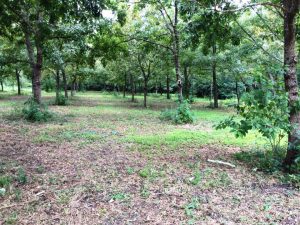
Photo 1 – Seventeen year old planting of sawtooth oaks in Gadsden County Florida. Photo Credit – Shep Eubanks UF/IFAS
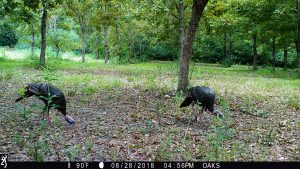
Photo 2 – Gadsden County gobblers feeding on Gobbler sawtooth oak acorns
Photo Credit – Shep Eubanks UF/IFAS
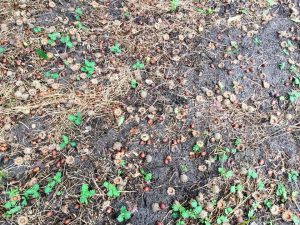
Photo 3 – Gobbler sawtooth oak acorns in Gadsden County. Notice the smaller size compared to the regular sawtooth oak acorn which is the size of a white oak acorn.
Photo credit – Shep Eubanks UF/IFAS
Southern Crabapple
Southern Crabapple is one of 25 species of the genus Malus that includes apples. They generally are well adapted to well drained but moist soils and medium to heavy soil types. They will grow best in a pH range of 5.5 – 6.5 and prefer full sun but will grow in partial shade as can be seen in photo 4. They are very easy to establish and produce beautiful blooms in March and April in our area as seen in photo 5. There are many other varieties of crabapples such as Dolgo that are available on the market in addition to southern and will probably work very well in north Florida. The fruit on southern crabapple is typically yellow green to green and average 1 to 1.5 inches in diameter. They are relished by deer and normally fall from the tree in early October.
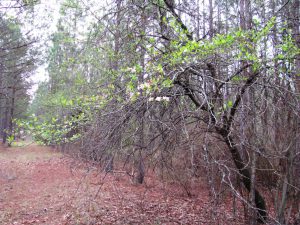
Photo 4 – Southern crabapple tree planted on edge of pine plantation stand. Photo taken in late March during bloom.
Photo credit – Shep Eubanks UF/IFAS
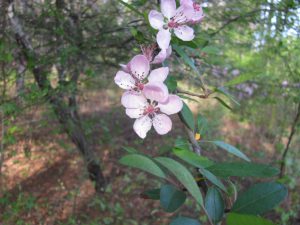
Photo 5 – Showy light pink to white bloom of southern crabapple in early April during bloom.
Photo credit – Shep Eubanks UF/IFAS
A good resource publication on general principles related o this topic is Establishing and Maintaining Wildlife Food Sources.
If you are interested in planting traditional fall food plots check out this excellent article by UF/IFAS Washingon Couny Extension Agent Mark Mauldin: Now’s the Time to Start Preparing for Cool-Season Food Plots .
For more information on getting started with food plots in your county contact your county’s UF/IFAS Extension Office

by Laura Tiu | Aug 3, 2018
Written By: Laura Tiu, Holden Harris, and Alexander Fogg
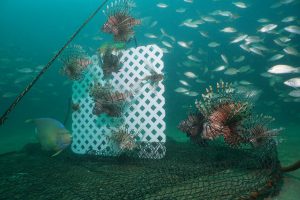
Non-containment lionfish traps being tested by the University of Florida offshore Destin, FL. Invasive lionfish are attracted to the lattice structure, then captured by netting when the trap is pulled from the sea floor. The trap may have the potential to control lionfish densities at depths not accessible by SCUBA divers. [ALEX FOGG/CONTRIBUTED PHOTO]
Red lionfish (Pterois volitas / P. miles) are a popular aquarium fish with striking red and white strips and graceful, butterfly-like fins. Native to the Indo-Pacific region, lionfish were introduced into the wild in the mid-1980s, likely from the release of pet lionfish into the coastal waters of SE Florida. In the early 2000s lionfish spread throughout the US eastern seaboard and into the Caribbean, before reaching the northern Gulf of Mexico in 2010. Today, lionfish densities in the northern Gulf are higher than anywhere else in their invaded range.
Invasive lionfish negatively affect native reef communities. They consume and compete with native reef fish, including economically important snappers and groupers. Their presence has shown to drive declines in native species and diversity. Lionfish possess 18 venomous spines that appear to deter native predators. The interaction of invasive lionfish with other reef stressors – including ocean acidification, overfishing, and pollution – is of concern to scientists.
Lionfish harvest by recreational and commercial divers is currently the best means of controlling their densities and minimizing their ecological impacts. Lionfish specific spearfishing tournaments have proven successful in removing large amounts in a relatively short amount of time. This year’s Lionfish Removal and Awareness Day removed almost 15,000 lionfish from the Northwest Florida waters in just two days. Lionfish is considered to be an excellent quality seafood, and they are now being targeted by a handful of commercial divers. Several Florida restaurants, seafood markets, and grocery stores chains are now regularly serving lionfish.
While diver removals can control localized lionfish densities, the problem is that lionfish also inhabit reefs much deeper than those that can be accessed by SCUBA divers. Surveys of deepwater reefs show lionfish have higher densities and larger body sizes than lionfish on shallower reefs. In the Gulf of Mexico, the highest densities of lionfish surveyed were between 150 – 300 feet. While SCUBA diving is typically limited to less than 130 feet, lionfish have been observed deeper than 1000 feet.
For the past several years, researchers have been working to develop a trap that may be able to harvest lionfish from deep water. Dr. Steve Gittings, Chief Scientist for the Office of National Marine Sanctuaries at the National Oceanic and Atmospheric Administration, has spearheaded the design for a “non-containment” lionfish trap. The design works to “bait” lionfish by offering a structure that attracts them. The trap remains open while deployed on the sea floor, allowing fish to move in and out of the trap footprint. When the trap is retrieved, a netting is pulled up around

Deep water lionfish traps being tested by the University of Florida offshore Destin, FL. [ALEX FOGG/CONTRIBUTED PHOTO]
The researchers are headed offshore to retrieve, redeploy, and collect data on the lionfish traps. Twelve non-containment traps are currently being tested offshore NW Florida. The research is supported by a grant from the Florida Fish and Wildlife Conservation Commission. The study will try to answer important questions for a new method of catching lionfish: where and how can the traps be most effective? How long should they be deployed? And, is there any bycatch (accidental catch of other species)?
Recent trials have proved successful in attracting lionfish to the trap with minimal bycatch. Continued research will hone the trap design and assess how deployment and retrieval methods may increase their effectiveness. If successful in testing, lionfish traps may become permitted for use by commercial and recreational fisherman. The traps could become a key tool in our quest to control this invasive species and may even generate income while protecting the deepwater environment.
Outreach and extension support for the UF’s lionfish trap research is provided by Florida Sea Grant. For more information contact Dr. Laura Tiu, Okaloosa and Walton Counties Sea Grant Extension Agent, at lgtiu@ufl.edu / 850-689-5850 (Okaloosa) / 850-892-8172 (Walton).


















